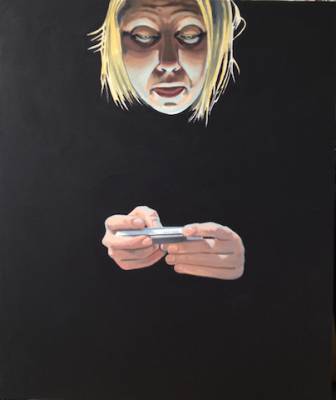By Elizabeth Trapp
For The Columbus Dispatch • Sunday July 19, 2015
In 25 oil paintings, Eva Andry holds up a mirror to contemporary society.
“Cell Phone Zombies,” at the Marcia Evans Gallery in the Short North neighborhood, zeroes in on that ubiquitous hand-held device of the 21st century.
The exhibit was organized by the gallery and Puffin Foundation West, a central Ohio nonprofit.
Andry paints scenes we’ve all seen. Zombies Hanging Out, Heads Up and Girl Talk feature groups of young people clustered together in what, in days long gone by, would have been boisterous get-togethers, animated verbally. But, in these groups, heads are turned down, with eyes transfixed on cellphones. If the paintings could talk, they wouldn’t.
Andry’s comments on contemporary technology are hard to mistake. In I Fear the Day, she includes a line of text from an Albert Einstein quote: “I fear the day that technology will surpass human interaction. The world will have a generation of idiots.”
Her paintings vary in their representation of human portraits. Zombies at Work, a portrait of three identically dressed businessmen on their phones, is stylistic, graphic and abstract . Cell Phone Zombie, from which the exhibit takes its name, is representational and highly detailed. A disembodied head floats in an ink-black atmosphere, illuminated by a cellphone light.
Birth of a Cell Phone Zombie shows a toddler transfixed by the light of the phone. Give Us This Day Our Daily Thread is a portrait of a family seated around a table at a diner — as silent as the rest of Andry’s subjects.
At least one group of paintings strikes an ominous chord. The “Distracted Driver” series portrays drivers looking at their phones. In one painting, a truck — visible through the driver’s window — seems headed directly toward the car. In another, a woman drives while looking at her phone; a child in a car seat can be seen over her shoulder. And at least one painting seems to find merit in cellphones. In Words Without a Face, two women wearing burqas hold cellphones in their hands. Even with their faces covered, they can find a voice and expression through their phones. The image seems to be a hopeful one in the midst of warnings.





